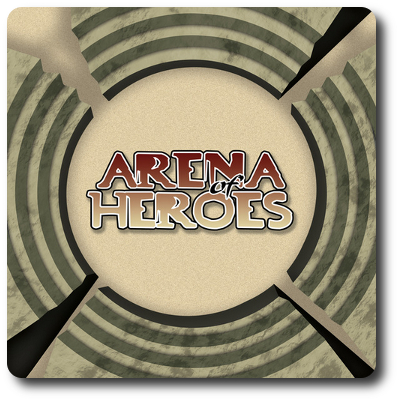
The Basics:
- For ages 5 and up (designer suggests 12+)
- For 2 to 4 players
- Approximately 20 minutes to complete
Geek Skills:
- Counting & Math
- Logical & Critical Decision Making
- Pattern/Color Matching
- Strategy & Tactics
- Risk vs. Reward
- Hand/Resource Management
Learning Curve:
- Child – Easy
- Adult – Easy
Theme & Narrative:
- Enter the arena and battle to become a living legend or a dead warrior
Endorsements:
- Gamer Geek approved!
- Parent Geek approved!
- Child Geek approved!
Overview
The roar of the crowd thunders in your ears as you squint in the bright light of day. All around you are mobs of people who call your name followed by shouts of luck and boos of disapproval. As a gladiator, you are used to it. Some of the spectators support you and some do not, but none of that matters. The only thing that is on your mind is surviving, and with each battle you win, your legend and notoriety grows. Let them boo. Let them cheer. But let them never doubt your courage and prowess as a warrior! Brandishing your weapon, you charge your first opponent of the day and tempt fate.
Arena of Heroes, by Wastex Games, is comprised of 1 game sheet (not mounted) that represents the fighting arena, 4 Hero pawns (in 4 different colors), 40 Life tokens (10 per player matching the colors of the Hero pawns), and 126 cards that are used to move, fight, and arm weapons.
Arena Preparation
To set up the game, first place the game sheet in the middle of the playing area. Each player should sit so they are facing one of the four sides of the square game sheet.
Second, have each player select a Hero pawn color and take 10 Life tokens that match the color of their selected Pawn.
Third, have each player place their pawns in one of the four corners of the game sheet. Place all 10 of the Life tokens in the designated Life tokens space.
Fourth, shuffle the deck of cards and deal out to each player 5 cards face-down. Players should look at their cards but keep them hidden from their opponent’s at all times. Place the deck, face-down, to one side of the game board, allowing room for a discard pile.
Determine who should go first and begin!
The Way of the Gladiator
The game is played in rounds with each player taking a single turn per round. Once the player completes their turn, the next player going clockwise starts their turn. A player’s turn consists of two sequential steps that are summarize here.
Step 1: Draw Cards
A player always draws up to 5 cards at the start of their turn. If the deck of cards runs out, simply shuffle the discard pile to create a new draw deck.
Step 2: Play Cards
A player must play at least 1 card on their turn and can play all the cards in their hand if they like. Discarding an item or a movement card does not count as a single play. The cards come in three different types.
Movement Cards – these cards show in what direction the player’s Hero pawn can move. Movement is always 1 square per movement card. The movement cards show a symbol that identifies the movement as diagonal, orthogonal, or player”s choice of the two (a star). The symbols are colored black.
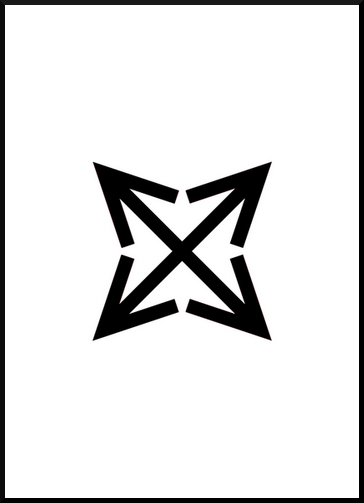
Example of a diagonal movement card
Combat Cards – these cards show in what direction the player’s Hero pawn attacks. Like the movement cards, a symbol is shown that identifies combat direction as diagonal, orthogonal, or player’s choice of the two (a star). The symbols are colored red. Combat cards also have a number value which identifies the strength of the attack. A player can only attack one square per card.
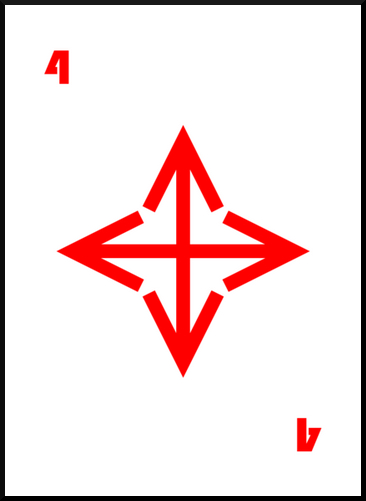
Example of an orthogonal attack
Item Cards – these cards represent weapons and armor the Hero pawn can equip in the arena. Weapons and armor provide bonuses during combat and are placed in front of the player in one of the two slot spaces on the game sheet. Some item cards take one slot and some take two. A player can always discard an equipped item card to replace it with another one, but only on their turn. The only exception to this rule is when an opponent throws a weapon or when a player is disarmed.
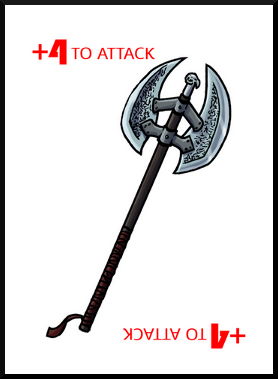
The Two-Handed Axe (takes 2 slots)
Life and Death in the Arena
A player will use their movement cards to approach a target, use their attack cards to smack them around, and then use their movement cards to get to a respectable and safe distance. How the player goes about this is up to them and is defined by what cards the player has in their hand on their turn, as well as their preferred strategy.
When moving, a player cannot go beyond the defined boundaries of the arena and cannot pass through or stop on a square occupied by another opponent. While not explicitly stated in the rules, it is implied.
Combat is conducted when a player plays a combat card. The value of the card, plus any equipped item cards, is the player’s combat value. Their target must now play a single combat card and hope that the value of the card, plus any equipped items, has a combined value that is equal to or higher than the attacker’s. If it is, the attack has failed, as it was blocked. If not, the attack succeeds and the target of the attack loses 1 Life token as a result. If the card is available, and the target of the attack wants to play it, the Disarm combat card can be played that automatically blocks the attack and takes away one of the attacker’s weapons.
The star combat card is a special attack and does not have a number value. These combat cards can only be blocked by another star combat card.
In the center of the arena is a special square that is considered “high ground”. If the Hero pawn is located there when attacking, a successful attack reduces the target’s Life tokens by 2 instead of 1. If the Hero pawn standing on the square is successfully attacked, the player who is attacking can decide to either push the Hero pawn into 1 square in any direction (essentially pushing them off) or reduce their Life token by 1.
Victory in the Arena
The combat continues until only one Hero pawn remains standing. That player is declared the winner and their legend grows, as does their ego.
To learn more about Arena of Heroes and read the full rules, visit the game’s web page.
Prediction
I think this game is somewhat deceiving…
From just reading the rules, the game is exceptionally straight forward: draw cards, play cards, rinse & repeat. But if you take a moment to look up from the rule book and envision how the game is played among the players and on the sheet, you start to see a much bigger and more complicated picture. What comes into focus is not a game of simply playing cards, but of outmaneuvering your opponent, collecting combinations for lethal attacks, and managing your hand so you always have a “Plan B”.
Teaching this game won’t take long, nor do I think this game will be out of reach of any of our play groups. The only area of concern I see is the lack of text that suggests an item card is single or double-handed (1 or 2 slots). But I should be able to mitigate the risk of a player confusing any of their item cards by creating a very simple “cheat sheet”, or better yet, draw a little symbol on the item cards that take two hands to wield. Or, I could simply show the only two cards that require two hands (the Two-Handed Axe and the Sword + Shield combo), which should also be sufficient.
The only other concern I have is two or more players ganging up on another player. But this is an arena in which only one player can be crowned champion. It makes perfect sense to team up against a common foe, as long as everyone realizes that it is nothing personal and a legit strategy. To help offset any frustration, I’m going to allow table talk and open deals.
As expected, teaching the game took all of a minute or so and none of the players ever had questions other than to clarify what I already stated. For example, “So we can play all our cards?” I told them yes, but was sure to note that they only get cards during their turn. This means they won’t have any options in combat if they don’t have any cards left in their hand. And so, as I set the game up for our first arena combat with my two little geeks, I asked them their thoughts on Arena of Heroes so far.
“Very cool! I like how I can throw an axe and you can catch it!” ~ Liam (age 8)
“Can I hold two swords, Daddy? AWESOME!” ~ Nyhus (age 5)
Looks like my two little geek gladiators are ready to rumble. Let’s see if this game is worth the struggle or goes down without even a hard tap on the nose.
Final Word
My little geeks and all the Child Geeks we played with had a wonderful time and became very good at the ducking and dodging that was needed to survive. None of them demonstrated any level of hand management control, however. This left them wide open to attacks from others, but they didn’t mind. It was more or less a brutal and chaotic battle with the Child Geeks, with berserker like tendencies as they rushed headlong into battle with little to no hope of defending any attacks during the following turns. A poor example of long-term strategy, but they were smiling the entire time. Total success.
The Parent Geeks were skeptical about this game, having not played a lot of combat games with their Child Geeks. Nor were they convinced that this would be a game worth playing with their peer group. After several sessions with their families and their friends, the Parent Geeks were more than happy to battle both child and adult alike in arena. The game played fast, was fun, and rewarded those players who took the time to think about their cards versus just knocking people out. This greatly impressed the Parent Geeks as the game allowed for a very aggressive and much more defensive type of play in equal measure without favoritism. Parent Geeks, both gamer and non-gamer, enjoyed their battles.
The Gamer Geeks were even more skeptical than the Parent Geeks. They turning their nose up to it based on its production value and scoffed at the idea that randomly drawn card driven combat could be tactical. After they played it, they stopped talking and started concentrating. Arena of Heroes is a game where smart plays and smart people will always win because they are watching the cards, watching their opponents, and playing the odds. Gamer Geeks are a special group as they always tend to look for the game within the game. Without looking long, they discovered that this was a game of outwitting your opponent with subtle feints, strong defensive stances, and blatant in-your-face aggression. They loved it.
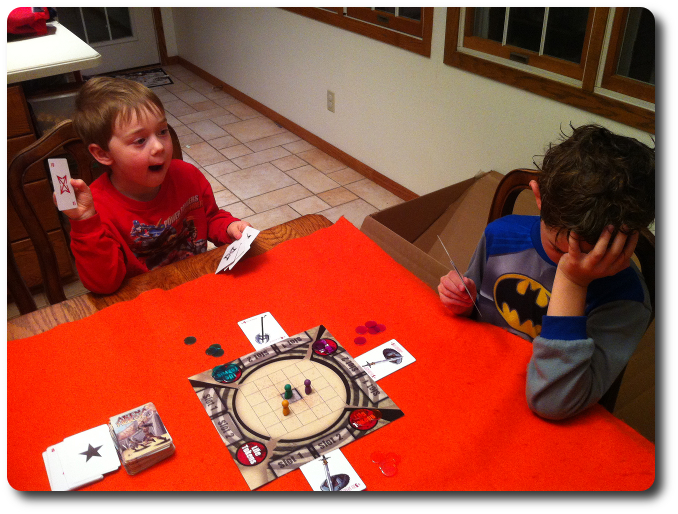
One little geek declares an attack on another…who obviously cannot defend against it
Gamer Geeks, this is a light game of strategy and tactics that will keep you surprisingly focused and engaged from start to finish. The need to be offensive and defensive at all times, and being allowed to act in both types of stances, gives the player a lot of control. Luck has been completely removed and the randomness of the cards is offset by hand management and smart card plays. While this will never be a game you will enjoy as the “main event”, Arena of Heroes is well worth your table time as a fast and fun filler, taking up to 4 players, and remarkably unforgiving to those who think it’s just a card game.
Parent Geeks, despite the violent theme of the game, your peer group approved Arena of Heroes not only for family play, but also with your peer group. Adults had just as much fun playing with the Child Geeks as they did the Parent Geeks. Although, a number of Parent Geeks quietly admitted they played less aggressively with their younger Child Geeks and held nothing back against their teenagers and adult friends. The only issue the Parent Geeks had was the initial rounds with four players that was an absolute chaotic mess. All the players would run for the center in hopes of taking control, only to all meet and beat each other down. This issue was quickly resolved, however, when one of their numbers was reduced and they all split up for tactical repositioning.
Child Geeks, this is a fast and fun combat game you can play at a very young age. There is very little reading and very simple math involved, but nothing taxing. The game’s level of complexity comes from the cards you’ll need to manage to ensure you always have a way to attack and always have a way to move. With only five cards in your hand, you’ll have to make some tough choices, but don’t worry or take too long trying to determine what the “right choice” is. This is a game meant to be played fast. If you think too long about your moves, you are playing it wrong. You can still play smart while being fast, however.
Arena of Heroes is an excellent example of a “beer and pretzels” game. If you are not familiar with this term, it describes a game that can be played very casually, is light on the rules, and has just enough strategy to keep you engaged, but never bogged down. Beer and pretzels are not required to play. The direct opposite of a “beer and pretzels” game would be a 2+ hour Euro-style game that demands 110% of your time and attention. Since Arena of Heroes is light, it makes the game very accessible to all three of our play groups, and not a single Child, Parent, or Gamer Geek was ever confused. And since it still employees strategy and requires some thought, it keeps everyone’s attention and never lets go. The end result is a game that is quick to teach, quick to learn, quick to play, and quick to love.
That being said, I am not altogether satisfied with the game.
The source of my disappointment is based on what the game currently does not have, but can easily be added or changed. First, the arena game sheet is not mounted on a board and is very flimsy. Not much of an issue when you consider it is played on a table, but the game’s level of durability is drastically reduced. My arena already has a crease, for example. Second, the game demands more. What you have in the game is a lot of fun, but your level of enthusiasm for it will begin to dwindle after you play it a few times. That’s because the same cards keep coming up. This can easily be addressed by adding more strategic locations in the arena, providing a wider range of items, and different attacks. One possible design choice that should be considered is allowing the cards to represent more than one card type at a time. For example, a card could be used as a move or an attack, but not both. The designer could add much more variety without actually adding any additional cards or complexity.
Other than that, no complaints and this game will remain in my collection. It is fun to play with the family as a filler or a starting game for the evening with my elitist Gamer Geek friends. But it will also be one of those games I will occasionally frown at because I know it could be more, do more, and achieve more. I can only hope the game designer revisits Arena of Heroes and improves the game with some simple tweaks and game component choices.
But would I recommend the game? Most certainly! If you are looking for a fast and fun game of light strategy and a great deal of outwitting your opponent, grab an axe and make your way to the Arena of Heroes!
This game was given to Father Geek as a review copy. Father Geek was not paid, bribed, wined, dined, or threatened in vain hopes of influencing this review. Such is the statuesque and legendary integrity of Father Geek.



